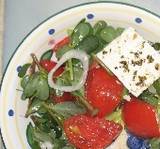Greek name and pronunciation:
Glistritha, γλιστρίδα, pronounced ghlee-STREE-thah (hard “th” sound)
At the market:
At the grocery store, you might find purslane leaves sold as a fresh herb packaged in disposable containers. It is sometimes available as a live plant sold in potting containers ready for transfer to your garden.

Greek Salad with Purslane
Physical characteristics:
Purslane leaves are 1/2 to 2 inches long, oval or paddle shaped, and succulent (e.g., fleshy and water-storing). The leaf has a central fibrous channel or stem extension, without pronounced branching of side channels. Leaves are usually in clusters of 5 or 6. Flowers are 1/4 inch long, yellow, with 5 petals, that contain salt-grain-size round black seeds. Creeping stems are reddish brown, about 10 inches long, with frequent branching.
Usage:
Purslane has many uses in Greek cooking:
- Use purslane raw and fresh in salads, sautéed as a side dish, or in soups and with fish and meats.
- A popular and very common summer salad in Crete is prepared with purslane and yogurt.
- Purslane may be preserved for winter use by pickling in apple cider vinegar with garlic cloves and peppercorns.
Origin, History, and Mythology:
In ancient Greece, Hippocrates, Galenus, and Dioscurides regarded purslane as an important medicinal herb for treatment of fever, female disorders, stomach aches, hemorrhoids, and for the healing of wounds.The 17th century monk Agapius Landus regarded purslane as a “cold” herb and prescribed a fresh garden salad made with purslane, basil, rocket, cress, and garlic to those suffering “the common cold.”Today, to many homeowners and gardeners, purslane is simply an invasive, pervasive, and ubiquitous weed, but modern medical research has found that purslane is five times richer in omega-3 fatty acids than spinach, and is high in vitamin C.
